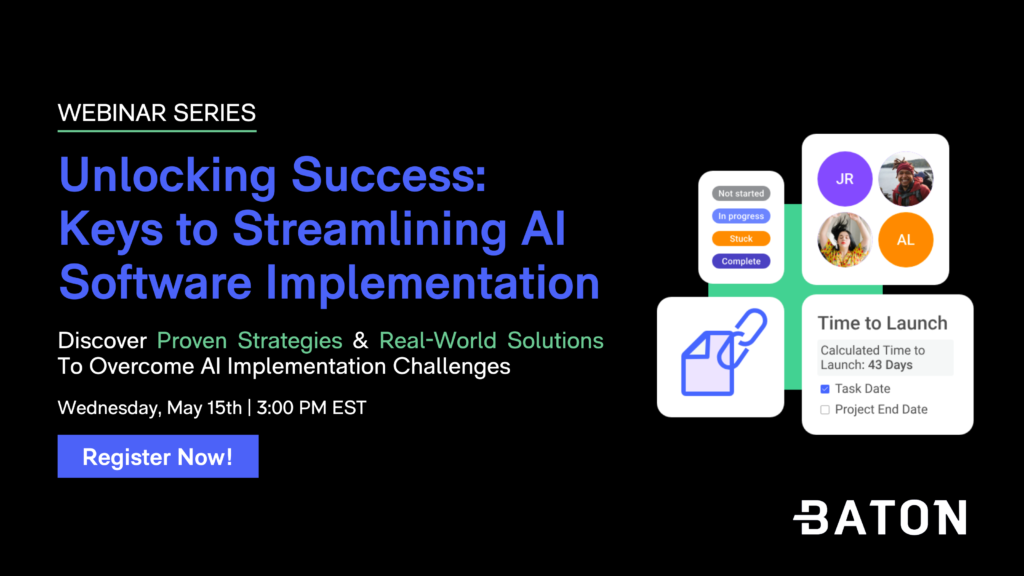In today’s rapidly evolving technological landscape, mastering software implementation is crucial for software implementation managers, especially when integrating AI technology into business processes. The implementation phase of the customer journey is where the rubber meets the road, determining whether the investment in AI yields significant returns or falls short of expectations. Here are five key steps software implementation managers can take to navigate and excel in this critical phase.
1. Define Clear Objectives and Scope
Before diving into the implementation process, it’s essential to define clear objectives and scope for the AI technology being implemented. This involves understanding the specific problems the AI solution aims to solve, identifying key performance indicators (KPIs) to measure success, and defining the scope of the project in terms of functionalities, timelines, and resources.
Clear objectives ensure alignment across the organization, setting expectations for what the AI implementation should achieve. For instance, if the goal is to improve customer support efficiency, the KPIs might include reduced response times, increased first-contact resolution rates, and improved customer satisfaction scores.
Defining scope helps prevent scope creep, where the project expands beyond its original boundaries, leading to delays and budget overruns. By establishing clear boundaries, implementation managers can focus resources effectively and deliver tangible results within the specified timeframe.
2. Collaborate Closely with Stakeholders
Successful AI implementation requires collaboration and buy-in from various stakeholders across the organization. This includes executives, department heads, IT teams, data scientists, end-users, and external partners or vendors. Collaboration ensures that everyone understands the goals, benefits, and potential challenges of the AI implementation.
Engage stakeholders early in the process to gather input, address concerns, and secure necessary resources. For example, involve end-users in user acceptance testing (UAT) to gather feedback on the AI system’s usability and effectiveness. Collaborating with IT teams ensures seamless integration with existing systems and infrastructure, while involving data scientists helps optimize AI algorithms and models for accuracy and performance.
Effective communication is key to maintaining stakeholder engagement throughout the implementation journey. Regular updates, workshops, and demonstrations help keep stakeholders informed and invested in the success of the AI implementation.
3. Conduct Thorough Data Preparation and Integration
AI technologies rely heavily on data, making data preparation and integration critical steps in the implementation process. Start by assessing the quality, completeness, and relevance of available data sources. Cleanse and preprocess data to remove noise, inconsistencies, and biases that can affect AI model performance.
Integration with existing systems, databases, and applications is another crucial aspect. Ensure seamless data flow between AI components and other business systems to enable real-time decision-making and automation. This may require API integrations, data pipelines, or custom connectors depending on the technology stack.
Data security and compliance are paramount considerations during data preparation and integration. Implement robust data governance policies, encryption mechanisms, and access controls to protect sensitive information and ensure regulatory compliance (e.g., GDPR, HIPAA).
4. Customize and Train AI Models
AI implementation managers must work closely with data scientists and AI engineers to customize and train AI models according to the specific needs and requirements of the business. This involves selecting appropriate algorithms, fine-tuning model parameters, and optimizing performance metrics such as accuracy, precision, recall, and F1 score.
Training data plays a crucial role in the effectiveness of AI models. Use diverse, representative datasets to avoid bias and ensure generalizability across different use cases and scenarios. Employ techniques like data augmentation, transfer learning, and model ensembling to improve model robustness and reliability.
Continuous monitoring and evaluation are essential post-implementation to assess model performance, identify potential drift or degradation, and retrain models as needed. AI technologies are not static; they require ongoing refinement and adaptation to maintain optimal performance over time.
5. Enable User Adoption and Continuous Improvement
The success of AI implementation ultimately hinges on user adoption and acceptance. Software implementation managers must focus on user training, change management, and user experience (UX) design to facilitate seamless adoption of AI technologies by end-users.
Provide comprehensive training programs and resources to familiarize users with the AI system’s capabilities, workflows, and benefits. Offer hands-on workshops, tutorials, and documentation to empower users to leverage AI tools effectively in their daily tasks.
Invest in intuitive UX design to ensure a positive user experience and minimize resistance to change. Solicit feedback from users regularly and incorporate user feedback into iterative improvements and feature enhancements. Continuous improvement is key to maximizing the value and ROI of AI investments over time.
Leveraging Purpose-Built Solutions for Streamlined AI Implementation Processes
Implementing AI technology involves navigating a complex landscape of data, algorithms, user interfaces, and integrations. To streamline this process and enhance efficiency, software implementation managers can leverage purpose-built implementation solutions designed specifically for AI deployments. Here’s how such solutions can add value to each step of the implementation journey:
1. Comprehensive Project Management
A purpose-built implementation solution provides robust project management capabilities tailored to AI implementations. It offers features such as task tracking, milestone management, resource allocation, and timeline visualization. Project managers can create detailed project plans, assign tasks to team members, monitor progress in real-time, and proactively address any bottlenecks or delays.
2. Integrated Collaboration Tools
These solutions integrate collaboration tools such as shared workspaces, document repositories, and communication channels. Team members can collaborate seamlessly, share documents, discuss ideas, and provide feedback within a centralized platform. This fosters transparency, accountability, and efficient communication across distributed teams.
3. User Adoption and Training
Purpose-built implementation solutions include user adoption tools such as interactive tutorials, guided tours, and knowledge bases. They facilitate user onboarding, training, and support through intuitive interfaces and self-service resources. User feedback mechanisms capture user sentiments, feature requests, and usability issues, driving continuous improvement and user satisfaction.
4. Performance Monitoring and Analytics
These solutions provide dashboards, metrics, and analytics tools to monitor AI system performance, usage patterns, and business impact. Real-time insights enable stakeholders to track KPIs, detect anomalies, and make data-driven decisions. Advanced analytics capabilities, such as predictive modeling and prescriptive analytics, empower organizations to optimize AI implementations for maximum efficiency and ROI.
5. Scalability and Flexibility
Purpose-built implementation solutions are designed for scalability and flexibility, allowing organizations to scale AI initiatives across departments, business units, and geographies. They support hybrid and multi-cloud deployments, containerization, and orchestration for seamless scalability and resource management. Flexible licensing models and deployment options cater to diverse organizational needs and budget constraints.
6. Continuous Improvement and Innovation
These solutions promote a culture of continuous improvement and innovation by facilitating agile methodologies, DevOps practices, and collaborative workflows. They enable rapid iteration, version control, and automated testing to accelerate time-to-market for new AI capabilities and enhancements. Integration with AI marketplace ecosystems and third-party APIs fosters innovation through access to pre-built models, data sets, and tools.
Incorporating a purpose-built implementation solution into the AI deployment process can significantly streamline workflows, improve collaboration, enhance data governance, accelerate time-to-value, and drive innovation. By leveraging the right tools and technologies, software implementation managers can master the software implementation phase of the customer journey with greater efficiency and success.
Interested in Learning More About AI Implementation?
Learn strategies to navigate the complexities of AI implementations and overcome common challenges.




